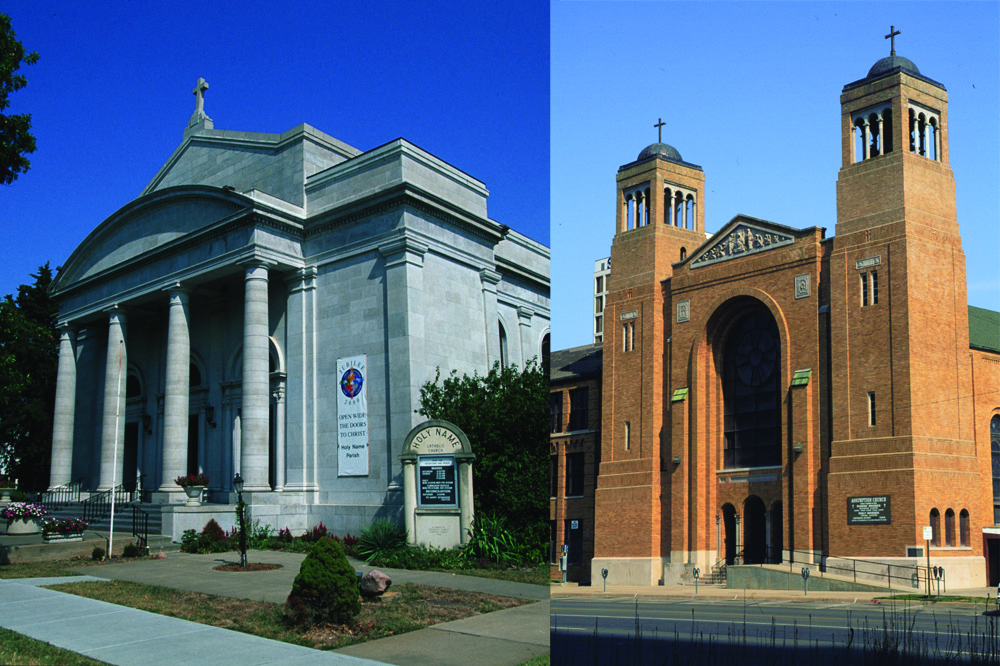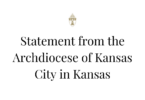
Mater Dei Parish in Topeka is comprised of Holy Name Church, left, and Assumption Church, right. Both churches have listings in the National Register of Historic Places. Assumption received its designation in 2008 while Holy Name received its designation this year.
by Marc and Julie Anderson
mjanderson@theleaven.org
TOPEKA — If you’re thinking of hitting the historic site circuit this summer, you won’t have to travel far to discover a twofer.
That’s right, Mater Dei Parish in Topeka lays claim to a fame that even San Francisco’s Golden Gate Bridge isn’t entitled to.
The parish is the proud possessor of not one, but two listings in the National Register of Historic Places as of January 2012.
The National Register of Historic Places is the nation’s official list of cultural resources worthy of preservation and is part of a national program to coordinate public and private efforts to identify and preserve historic and archeological resources.
To qualify for inclusion on the register, the property must meet certain criteria. For example, it must be associated with significant events in American history or have an association with the lives of persons who were significant in the nation’s past.
Generally speaking, religious structures and properties used for religious purposes are not eligible for inclusion on the register, although there are exceptions. Mater Dei met an exception.
Mater Dei was formed in 2006 from the merger of the former Assumption and Holy Name parishes. Just two years after the merger, pastor Father Jon Hullinger and parishioners began to research the guidelines and application process for the Church of the Assumption to earn a listing on the register.
At the time, the church’s rose window desperately needed repair and funds were limited. Mark Burenheide, then a member of the parish finance council, advised the parish that a historic designation meant that tax credits could be used to help pay for repairs and other future needs.
Despite being a religious building, parishioners learned Assumption Church might meet at least one of the exceptions — that of being in proximity to a historic district.
Assumption Church is located across the street from the Kansas state Capitol, already designated a historic district. The church, the third built on the site since 1862, was designed in the mission/Spanish revival and Renaissance styles.
Holy Name Church, like Assumption, falls within or on the edges of a historic district. The parish, founded in 1914, is near two historic districts — the late Gothic-style Topeka High School and the impressive homes of Governor’s Row.
Given Holy Name’s proximity to these structures, both Burenheide and Father Hullinger thought it made sense for the parish to apply for another designation.
Holy Name was built in 1925 and is modeled after Chicago’s St. Ignatius Church. Holy Name’s design is in the Renaissance revival style and features a dressed Carthage limestone exterior with Tuscan Doric pilasters at all corners and junctions, and a tile roof.
“One of the interesting things we learned during the application process is that parishioners held a parish bazaar to raise money to build the church [initially], and [the parish bazaar] is one tradition that survives today,” said Burenheide.
Both churches of Mater Dei represent the faith and sacrifices made by earlier generations of Catholics, said Father Hullinger. He feels called to do his part to hand these structures on to future generations.
“It’s pretty obvious that were building on two wonderful and beautiful traditions and that we’ve been given an opportunity to hand on not only the beauty, intellectually and spiritually of our Catholic faith, but [also] architecturally and artistically,” said Father Hullinger.






